Artist Interviews 2022
Thitz 
By Laura Siebold
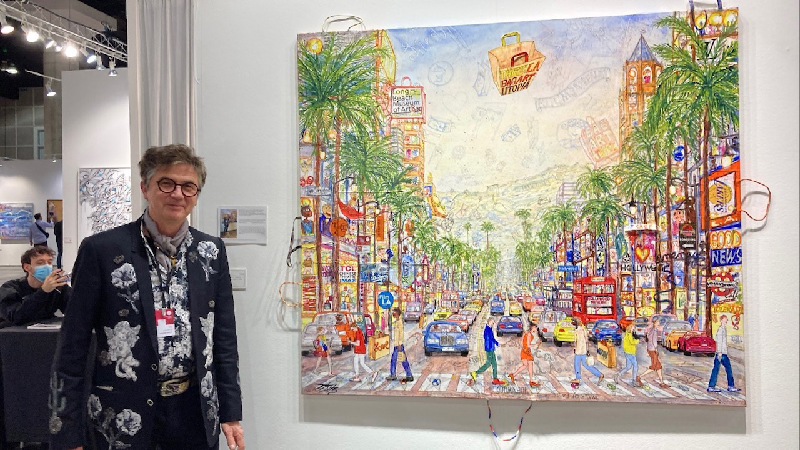
Thitz is a German artist whose works are well known and in high demand worldwide. THITZ storage is empty since years - because all new works are exhibited or sold. As part of his unique "Bag Art Paintings", THITZ uses paper bags as material on the canvas and as well as for communication. His works are absolutely unique, colorful, sometimes strange or bizarre, intriguing and have a richness of detail that makes it possible to discover things in the pictures even years later.
Thitz works in the tradition of Pop Art; he develops it further, intensifies it, and integrates the poles of everyday reality, art, life and their sensorial experience into a new form of art. Thitz produced his first bag picture in 1985, more than 30 years ago, when he was studying under the great informal master K.R.H. Sonderborg at the Stuttgart State Academy of the Visual Arts. The fact that Thitz uses bags as a surface for his pictures is no accident but an integral element of his concept. The handle applications of the bags loop out over the edge of the picture. They breach the sharp linear contours of the picture and evoke associations – the picture as bag and the picture over and beyond what is depicted as a receptacle for content. (Introduction provided by the artist)
We discovered Thitz's art at the LA Art Show in 2022 and were intrigued, not only by his oddly charming differently colored shoes, one of his trademarks.
In his interview, the artist tells us about his special "Bag Art" technique, the two levels of perception embedded In his artwork, and his use of recycled materials.
Thitz also introduces us to the power of advertisements in the Western world, largely influenced by U.S. culture, and to the multiple layers of his work. Thitz shares his " artistic vision of a peaceful and sustainable world".
While Thitz has exhibited his art all over the world, he remains in his homebase in Stuttgart, Germany.
Art currently on view at
Artplex Gallery in Los Angeles
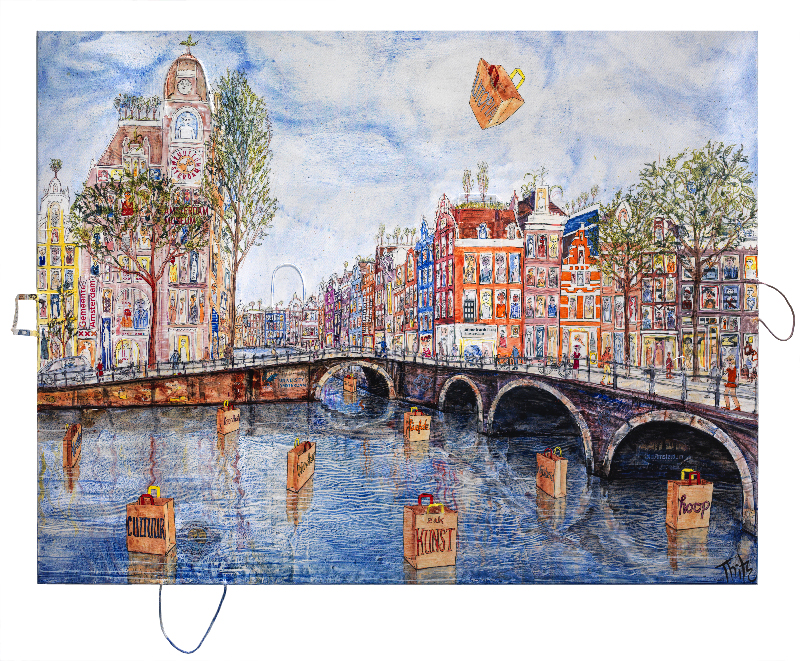
You are known for your "Bag Art". Can you explain the idea behind your technique to our
readers? How did you come up with this idea of creating a layered art product, both in
terms of reusable materials and meaning?
Basically, during my studies I already had the idea that as an artist I have to follow my own personal idea as precisely as possible and accordingly develop my own personal techniques. The reason is simple: there are no two identical people in the world! So, if you follow your own ideas precisely, something new and previously unknown automatically emerges. A nice effect is also that you don't have to pretend or adapt and therefore you always have fun at work!
Already during the development, I tried all kinds of objects, which I glued on the canvas to then paint on it. These were exclusively recycled, that is, found objects, from the garbage or even used things by myself, such as bags, books, newspapers, circuit boards, ropes ... a special inspiration came from those objects that revealed the history of a former owner or its cultural origin. In the end, while searching for my own technique and style, it turned out that bags were the best fit for me. They have a visible and often readable surface, which tells something about the cultural environment from which they come. In addition, they have a hidden interior, a content that cannot be seen from the outside, which thus promises a discovery, a mystery. To connect these two levels of perception and to bring them into an artistic form has always been my concern.
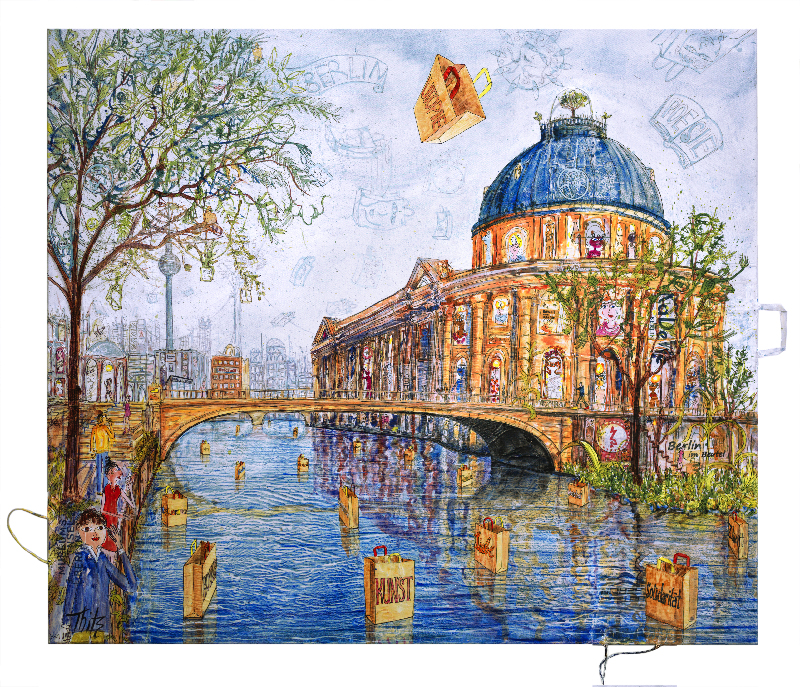
You received art education both in Germany, and Spain. How have the different
influences shaped you and your artistic expression to this day?
First, I learned that people in different cultures also perceive art with different eyes. For me, this created the opportunity to implement those skills and ideas preferentially, which were more at home in the respective culture. During the many journeys I made during my studies, I tried to transport back the respective cultural views as a kind of reporter, in the form of my watercolor studies. This resulted in tens of thousands of watercolor studies, on the trips I have painted virtually permanently, even on the bus, train or on a traffic island.
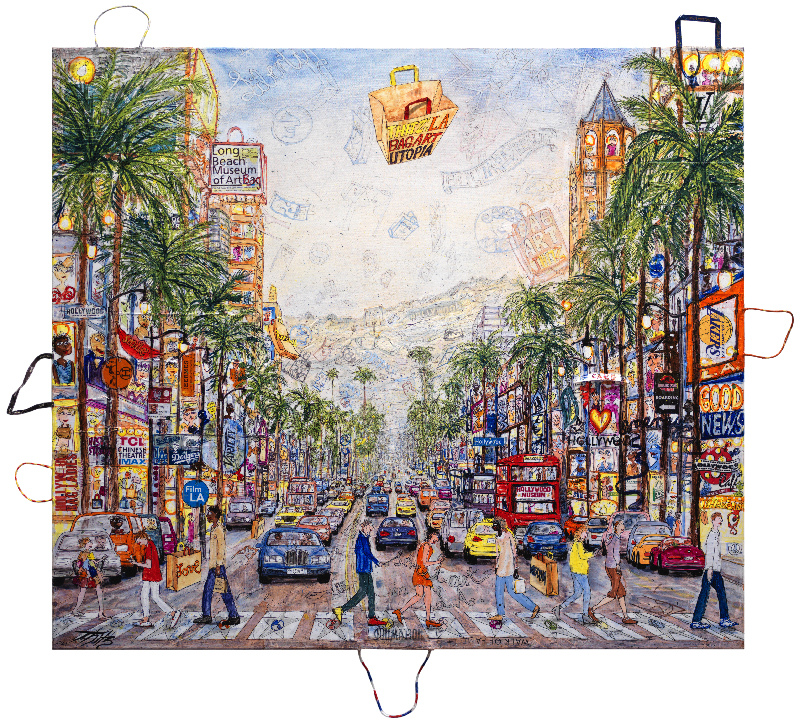
How do you translate your view of the world into visual images on paper bags?
If I want to paint a new motif, for example, a view of New York, I look for the watercolor studies and of course the bags from my last trips there and first begin to imagine from which point of view I want to tell the picture. That could mean to put myself in another person's shoes from the other culture or even from the city I want to paint and tell the picture from their point of view, but naturally with my own style. The bags are thereby inspiration, can awaken memories of previous trips there. These bags can also trigger the same in the viewer. The picture grows slowly. The first brushstrokes are with little paint practically with dirty water. So gradually the color becomes stronger and the instruments become finer. From the large brush to the small brush to the reed pen and in the end the ink drawing as the finest instrument. In the Utopian Civilizations pictures, even the ink is still used diluted in five stages.
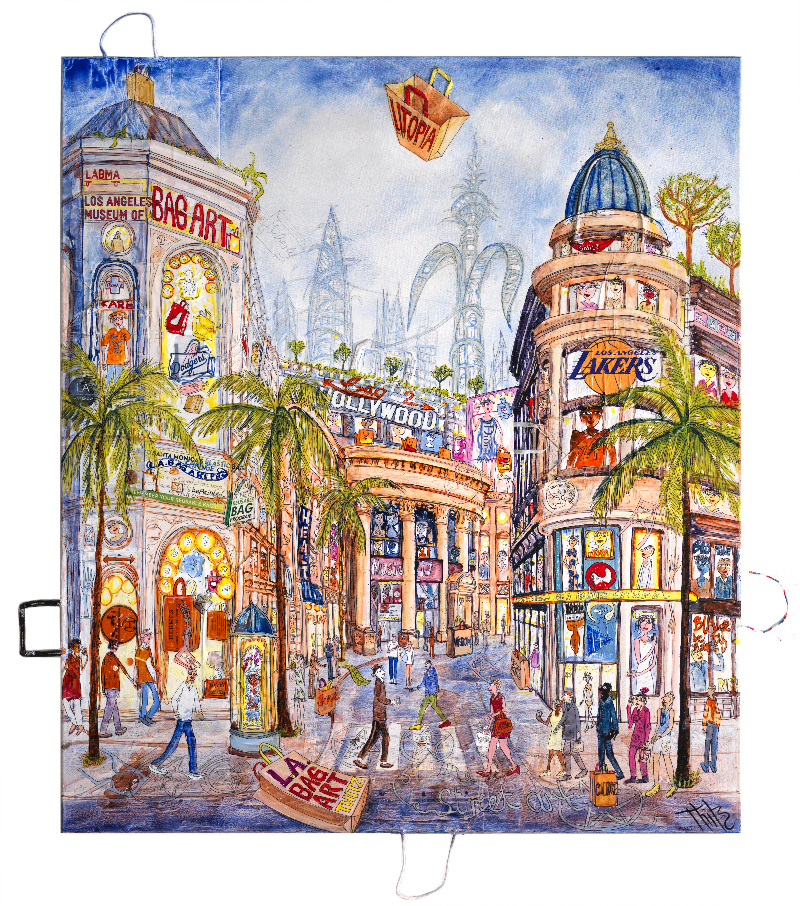
You document transient, yet repeating moments of everyday life, often defined by
distractions through advertisements in cities. In your opinion – apart from the material
you use, what is special about your urban scenes and what distinguishes your style from
other artists?
I was as a teenager on the East Berlin side while the wall in Berlin still stood, when I came back to West Berlin, I saw the advertising and the many colorful lights with completely different eyes.
There was simply nothing like that in East Berlin! Until then, I always found advertising pretentious and unpleasant, annoying. But at that moment I understood that these colorful lights are part of our liberal culture, which has always been influenced by American culture, specially in West Berlin.
The billboards no longer seemed so pretentious to me, and I understood them more as an invitation. The decision to paint cities came about during my scholarship in Barcelona. Until then I had only painted landscapes, I often walked for hours out of the cities and then painted my watercolors in the countryside in the middle of nature. In Barcelona I noticed the similarities, we humans are also part of nature. I began to deal with this part of nature. But since my first daughter was born, I have become a real fan of people.
My style is as different from any other artistic style as the people who implement their style are different from each other. My approach has never been to submit stylistically to a particular fashion or current, yet there are of course influences from everyday life, and also from the art scene that influence my own living space and thus my artistic style. I notice some similarities with Pop Art, Andy Warhol but am also a fan of a lot of different people like Obama, the artist Rauschenberg, the musician Amina Claudine Meyers and the philosopher Davis Hume.
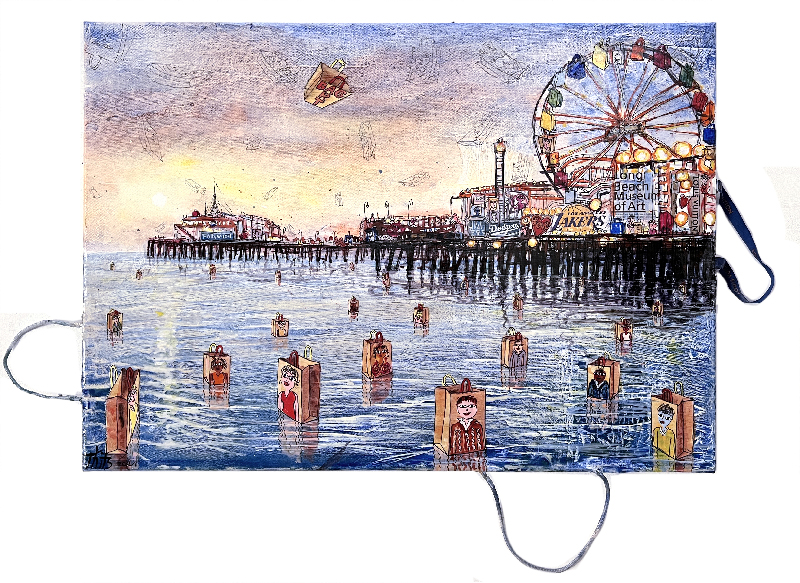
Your Bag Art consists of both silkscreen printing and painting. How do methodology,
color, subjects, and materials work together in your artwork? Have you made changes to
your style or method over the years? Why/why not?
The Bag Art actually consists only of canvases, bags and acrylic paint. Silkscreen, I use specially for the editions, which are originally made for the same reason as Andy Warhol originated - simply to be able to make my art accessible to poorer people.
The paintings have actually evolved significantly over the years. Whenever I reach a certain quality, I immediately start looking for the next opportunity to improve. Thus, 15 years ago I completely changed the painting from previously opaque painting to lazure technique. This opened up the possibility of details and stories much finer and more complex to tell. However, this painting on acrylic paint basis is extremely complicated, especially because I paint with liquid colors on horizontal canvases and with both hands at the same time. Also, there are often long drying times, during which the paintings look terrible. Only the knowledge that this condition is necessary to achieve a maximum quality then allows me to keep painting. My ambition is always to be able to represent as much information or multi-layered levels in the paintings as possible. More is always better! So, the works over the years became more and more multilayered and more detailed.
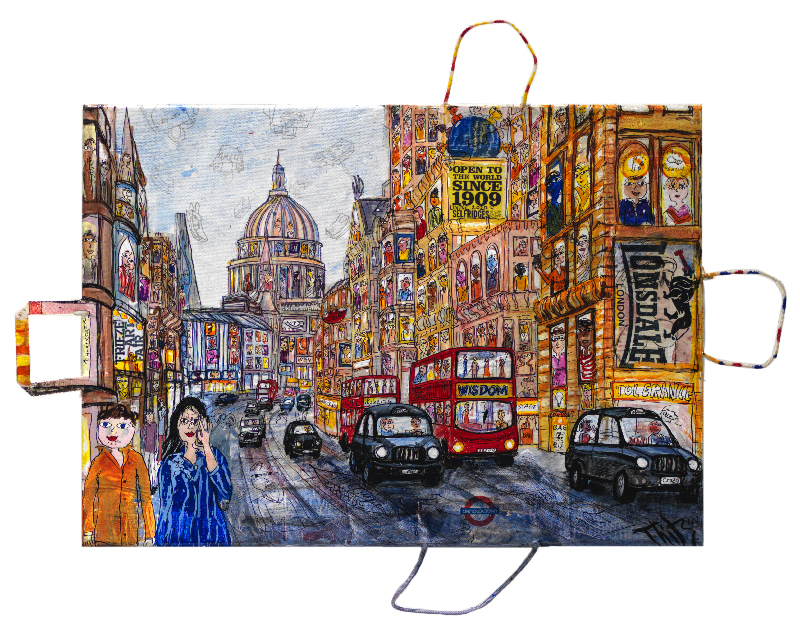
You've exhibited your work internationally and have worked with different artists and in
different cities over the course of your career. What have you learned from these experiences and has your work been received differently in different countries?
In fact, I have already worked and exhibited in over 30 countries. Interestingly, I have apparently managed to find a kind of global cipher that is understood everywhere. Possibly, the one has also only emerged through the other, I mean many trips have simply imprinted a global world view, which is then stylistically reflected in the works. In fact, depending on the culture, certain information or levels of the images are perceived differently. For example, I noticed in the Asian region that people perceive the surface of the information (bags, city views, faces) equally important as, for example, hidden messages, philosophical connotations, or associatively generated impressions. These are things that we in Europe usually discover consciously only at second glance.
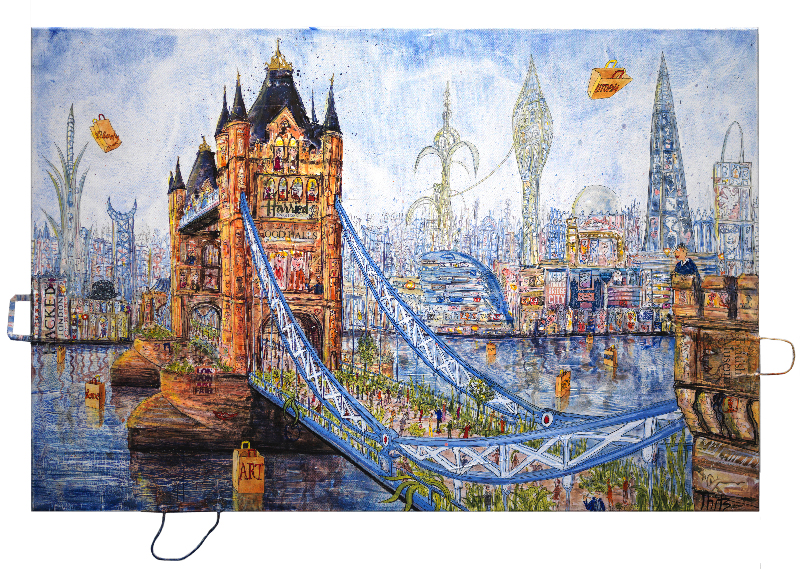
We find yourself as a painted subject in many of your art products. In your opinion –
what is the role of both the artist and art in our current state of the world? Can art
provide healing, or does it disguise and distract from reality?
The more unique and whimsical my works became, the more I found it necessary to let myself appear there as a character. Simply to also show that one stands to it and that I live in this world also myself.
Artist is one of the few still free professions of our time! I think we have thereby even the duty to show the reality and to contribute to the healing of unfreedom, injustice or discord. My task, [as] I see [it], for example, [is] to create visions of a better world. These visions are all the more important in a society where everyone actually already has everything he needs but can no longer imagine how it should be even better. But if this culture of prosperity is based on the exploitation of the resources of the planet or even on the backs of poorer people in other parts of the world, there are very well visions of how to improve our world and culture still. I paint this world in which everything is as it should be, people live together peacefully and in harmony with nature, without wars and without any external differences among people causing problems. If we have a better world in front of our eyes, a painting which visualizes a dream of it, we are more likely to succeed in realizing it.
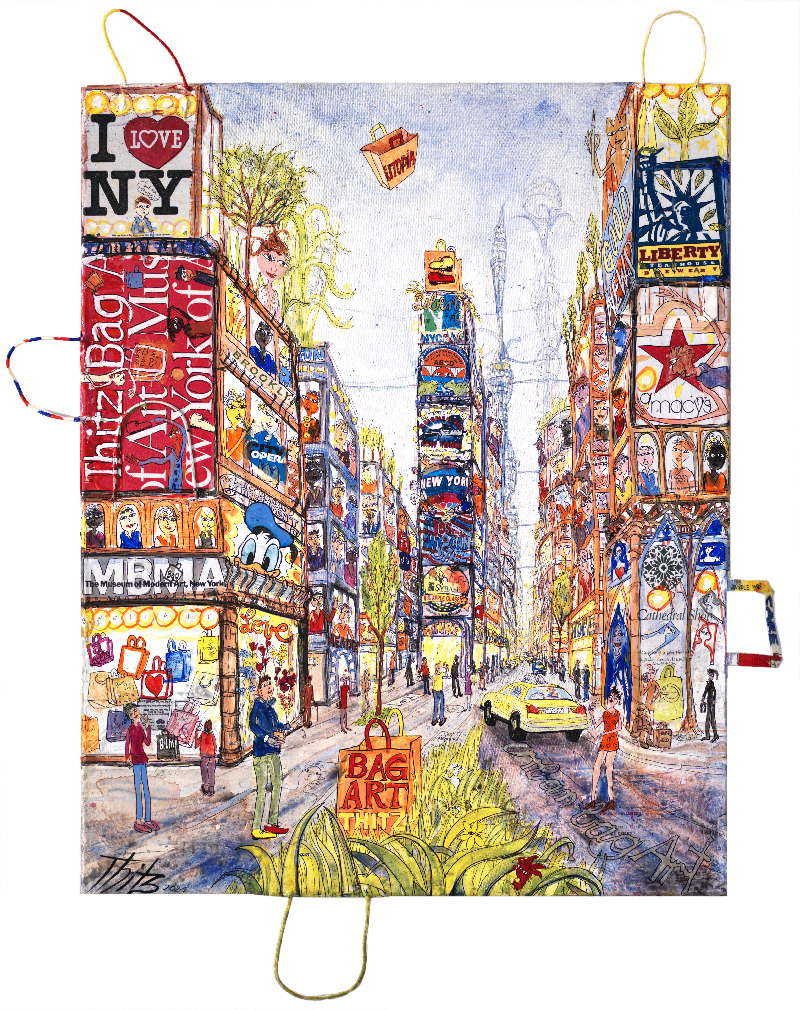
What is the collection or specific artwork you've created within your career span of over
forty years that you're most proud of and why?
In the meantime, a large number of museums but also private collectors have bought my works and integrated them into their collection. This makes me very happy, of course, because this creates the opportunity for all people to view my works once in the museum. But it also makes me a little proud that there are hardly any paintings of mine that are sold again. So, the paintings are somehow sustainable enough and give inspiration and positive energy to the people who bought them, also after many years. They want to keep them even if the value of the paintings is increasing.
But I also always enjoy the Bag Art Global project I organize mainly during my museum exhibitions worldwide. The people of the city are asked to send me their idea of an artistically designed bag. Out of these I then created an installation that was exhibited in the museum in a prominent place, and the results were usually overwhelming! Here, too, it has been shown that one can reach people very well if you ask them a question that can be answered really openly and freely. What is your idea of BAG ART?

Have you ever carried around any of your finished bag products and "recycled' art by reusing
the bags as an everyday product? If your art is purchased by private collectors, where do you hope to see it exhibited? Would you encourage your buyers to re-use your art as shopping bags?
Especially with the Bag Art Global projects, of course it often happens that the project becomes an issue in a city, and people look at their shopping bags with completely different eyes. They work on them and paint them or speak a poem in them before they hand them to me. By using these bags for an artistic installation in the museum, they are recycled again. Afterwards, the people get their designed bag back, and the bags are recycled again. Most then hang their bag framed, and together we have created a quadruple recycled work of art.
Of course, the finished canvas works can no longer be used for transportation of goods. However, the images indirectly transport the cultural time spirit and my artistic vision of a peaceful and sustainable world.
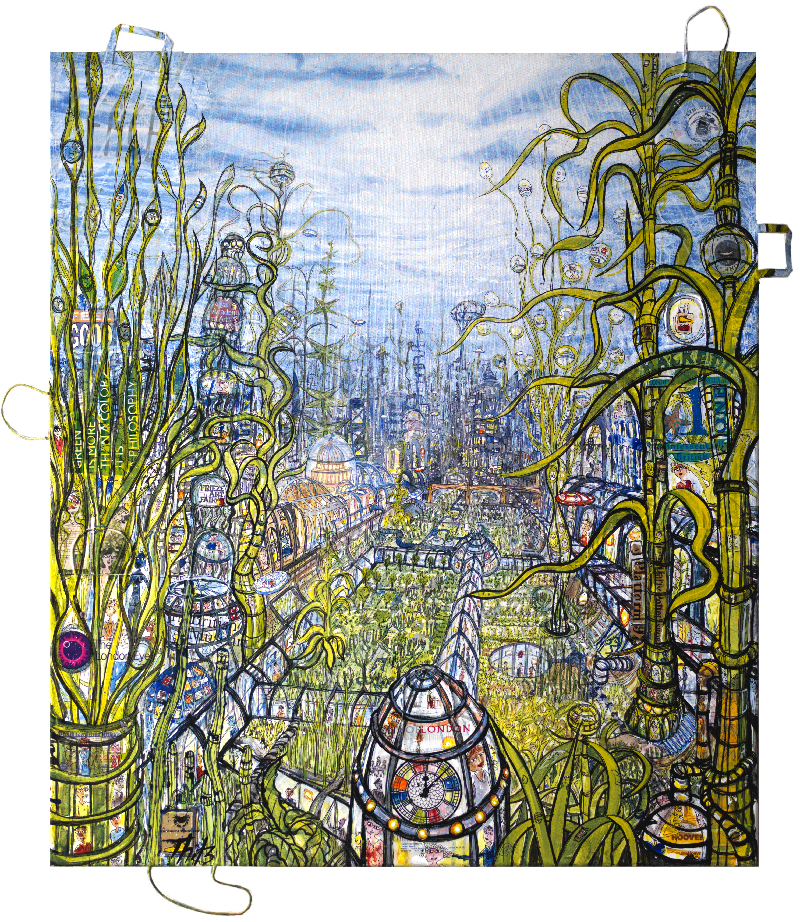
You told me about an upcoming exhibit at a gallery in L.A.; a byproduct of your exhibit at
The LA ART SHOW 2022. What do you hope to gain from this collaboration and what are your plans for the future?
At this year's one artist show with Neue Kunst Gallery at LA ART SHOW 2022, it turned out that there will be a collaboration with Artplex Gallery at 7377 Beverly Boulevard [in] Hollywood. The paintings are already on display there and there will certainly be a solo show as well. I am very happy that I now have a gallery representation in the USA again, besides Korea and many galleries in Europe. For the future I wish you all health and a quick end of Putin's war and of course that all my visions for a positive future come true.
|
|

